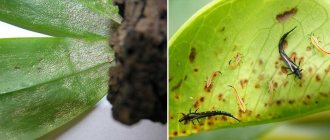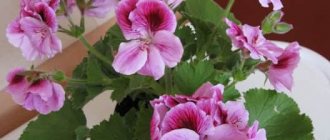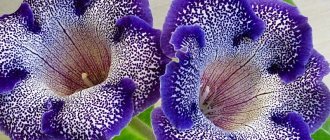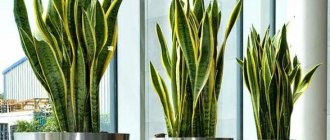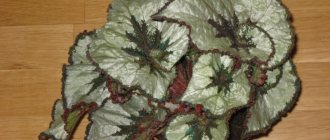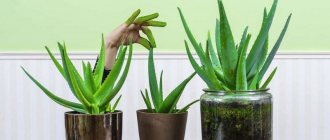Is there an allergy to geranium, given its benefits?
In folk practice, geranium
is quite common for treating infections of the mouth and nose.
It has many beneficial properties
, which are expressed in antibacterial and antiseptic terms. Folk recipes with geranium allow you to create decoctions that are used for various laryngeal and oral infections.
Among other things, geranium has the following properties:
- it is used as an anti-cellulite agent. It speeds up the work of blood and its circulation in the body system;
- has a beneficial effect on the cardiac system;
- prevents the development of tachycardia and coronary disease;
- purifies the air;
- improves the home atmosphere.
For a long time it was worth having a pot of geraniums in the house, then peace and comfort reigned in the house, and the children grew up as obedient and kind people.
Causes of allergic reactions
While cultivating green spaces, a person may notice the following symptoms: constant runny nose, sneezing, puffy eyes, incessant cough. Often the patient mistakes the symptoms of an allergy to indoor flowers for an infectious or cold disease, without stopping contact with the allergen.
There are a number of reasons that contribute to the development of allergies to green spaces:
- A predisposition of the body, manifested by allergies to food, household chemicals, indoor dust or certain types of mold, hair or fluff of pets, etc.
- External factors that reduce the body’s protective properties: poor environmental conditions, living in areas with high gas pollution, cigarette smoke.
- Types of flowers that pose a danger to allergy sufferers, which are unknowingly grown at home.
Allergy to wild and domestic flowers often manifests itself in the form of hay fever (allergic manifestations to pollination of flowers). The main source of trouble in such cases are wild shrubs and trees, which bloom in late spring and early summer.
During this period, an allergy to indoor flowers may begin, and the symptoms of the disease will be similar to those of hay fever.
Often, negative manifestations on the flowering of indoor plants are not associated with pollen at all. An allergic reaction of the body can be triggered by the soil in which the plant is planted. Allergies develop to various types of soil amendments that are used as fertilizers.
Mold, which develops on the soil in cases where the flower is not properly cared for, is also an allergen. Excessive watering is necessary only for moisture-loving plants; otherwise, some of the water remains in the soil, causing the development of mold on its surface and on the walls of the flower pot.
Direct contact with some types of indoor flowers can lead to skin dermatitis. The stems, leaves or roots of the plant in rare cases cause a violent allergic reaction when touched.
In such cases, the following symptoms of the disease are most often diagnosed: skin rashes such as urticaria, rash all over the body, especially in places of contact with the plant (hands, wrists), severe itching.
Juice from the leaves of a number of indoor flowers can also cause unpleasant manifestations, for example: orchid juice is dangerous if it gets on the mucous membranes, because the plant is considered poisonous. Young children often taste the bright flowers and beautiful leaves of home gardens.
Pollen allergy
An allergy to pollen from flowering plants is called hay fever. or seasonal allergic rhinitis (runny nose), or hay fever.
Pollen is one of the reproductive elements of flowering plants. Therefore, the period of occurrence of hay fever is usually limited to the spring flowering period. However, symptoms of the disease can appear all year round.
Currently, the incidence of hay fever is about 15%. In approximately 80% of cases, the disease is characterized by a hereditary predisposition.
Causes of pollen allergies
During the flowering season of plants (grasses, trees, shrubs), pollen from the air gets onto the mucous membranes of the nasal cavity (further into the bronchi), the conjunctiva of the eye and onto the skin. If a person is allergic to flowers, the immune system recognizes pollen as a foreign substance that can harm the body. Immunoglobulins (immune proteins), histamine and a number of other biologically active molecules are produced, which trigger a cascade of reactions aimed at eliminating (destruction and removal) of the allergen, which is clinically manifested by symptoms of the disease.
Allergy symptoms
The symptoms of pollen allergies vary widely. But the pathological process is based on a substance called histamine released into the blood. Histamine dilates blood vessels, causes inflammation in the mucous membrane of the nasal sinuses, which is accompanied by redness, swelling, swelling, as well as in the mucous membrane (conjunctiva) of the eyes. These changes are manifested by a runny nose (fluid, light, non-purulent). The physiological role of a runny nose is to remove the allergen, and swelling (edema) is to prevent its spread in the body.
Similar changes occur in the conjunctiva, which, due to the influence of the above substances, produces a large amount of tear fluid. In addition, there is itching and redness of the mucous membrane.
Diagnosis of the disease
You can determine whether you have a pollen allergy using ordinary observation. If in spring or summer, especially at a certain time interval, symptoms of the disease appear, you need to study the entire plant world around you. Flowering calendars can help with this.
The doctor will ask you to conduct skin tests (scarification test), which can reveal which flowers cause allergies. In addition, a blood test for class E immunoglobulins, which are produced in the body when encountering a particular allergen, is highly informative.
Treatment of pollen allergies
Treating pollen allergies is not an easy task. since it is almost impossible to completely protect yourself from contact with her. When going outside, wear a mask (medical type), which will allow you to reduce the amount of pollen in the inhaled air. Wear glasses over your eyes (you should wipe them from dust or wash them as often as possible).
Medicines used:
- Antihistamines (prevent the formation of histamine): Claritin. Allegra, Zyrtec. Diphenhydramine, Loratadine;
- Decongestants (relieve swelling, thereby reducing the amount of secretions such as tears and runny nose): Neo-Synephrine;
- Cromolyns (suppress one of the types of cells involved in the allergic reaction): Nasalcrom;
- Steroids (hormones that suppress the inflammatory response): Flonase, Nasonex;
- Saline solutions (wash out the allergen): Aquamaris.
Pollen allergy in children
In children, the treatment of allergies should be approached with special care, since in some cases it can develop into a serious systemic reaction, such as bronchial asthma.
No comments yet!
Source: orebenkah.ru
Causes of allergies to house flowers
The fact that plants are living organisms and they have the ability to breathe has long been widely known. But when breathing, the plant can release various substances, both useful and dangerous to humans. For example, the same phytoncides - volatile substances that disinfect the air, can in some cases provoke allergies. A common cause of allergic reactions is the essential oils that give the plant or its flowers their aroma.
Do not forget that most plants (and indoor plants are no exception!) bloom, and naturally do this with the formation of pollen. Its particles can spread throughout the house or apartment, becoming, like pollen from wild plants, the cause of allergies to flowering.
Not only pollen is dangerous; allergic reactions can be caused by leaves and even the trunk of the plant - the juice protruding on them, the spines or hairs with which they may be covered. In addition, plants with large leaves, if not properly cared for, turn into real dust collectors, which is bad for both the plant itself and its owners.
It is impossible not to mention modern fertilizers and pesticides, which have to be used from time to time to treat a green pet. At the same time, the air around receives a fair portion of the contents of the periodic table, and this can cause serious harm to the residents of the apartment.
The harmfulness of indoor plants - myth or reality
An allergic reaction does not occur in all representatives of the earth's population, but only in people who have a genetic predisposition to reactions to any plant. Currently, a list of indoor inhabitants that can cause allergies in humans has been determined. Some people, having learned about the danger, begin to quickly clear the room of green decor. In fact, this is huge stupidity. Houseplants are just as dangerous as pills or detergents. If such plants are left in a visible place near children, they may taste them, and in this case they will cause a lot of trouble.
There are flowers in the house that have poisonous juice, which, when it gets on the skin and mucous membranes, causes severe irritation. The effect of such flowers is expressed in excessive tearing and is manifested by the appearance of red spots on the skin. Their juice, getting into the eyes, begins to burn. These include flowers whose leaves ooze white liquid when the leaves are cut. Akalifa, codiaum, poinsettia and Mil's milkweed have this property. Monstera, ficus, dieffenbachia and aglaonema are also considered poisonous. When transplanting the above plants, you must wash your hands and under no circumstances put your hands in your eyes or mouth, or better yet, wear gloves.
Avid lovers of house plants can say that they have not felt any negative effects from their pets. For such people, it is normal to handle flowers very carefully, replant them with gloves and not eat food at this time, but if there is a small child in the house, it is worth removing such flowers from his reach.
The presence of indoor plants that cause allergies in one of the household members is very dangerous. If you experience itching, rashes on the skin, excessive salivation, swelling of the eyes or other areas of the body, you should go to the doctor. Breathing may also become difficult and a cough may appear. If an allergy occurs, it is better to throw out the dangerous plant or give it to your neighbors.
Very common indoor flowers, such as geranium or primrose, can also cause allergic reactions.
For more than half of humanity, allergies to indoor flowers are rare, and therefore it is quite stupid to be afraid of geraniums, which people have been growing for centuries. There are plants that are grown to decorate the interior. Due to the presence of brightly colored fruits, such plants are very attractive to children, who can swallow the tempting fruit and become seriously poisoned. Such plants are pepper or nightshade, and it is not recommended to decorate a child’s room with them. Azalea leaves are highly poisonous, hydrangea and philodendron are toxic. If they enter the human body, they can cause serious damage.
Substances contained in oleander, adenium, mandeville and carissa can cause serious damage to a person’s cardiac activity. Of course, if you just look at the representatives of this family, they will not cause harm. Serious problems can arise when the leaves of these plants are eaten. There are people who self-medicate with plants, but without sufficient information about the plant, you should not use it for treatment.
It is recommended to be careful with flowering and fragrant indoor plants. Without ventilating the room during the flowering period, you can get headaches and dizziness. In general, indoor flowers create a cozy atmosphere and decorate the house; they add joy to life and improve your mood. Therefore, by handling flowers carefully, you can ensure complete safety and not cause harm to your health.
What is important to know about indoor plants for asthma?
First of all, it is important to take into account the characteristics of your own body and listen to it. After all, what helps one person may not work for another. But nevertheless, there are a number of rules that must be followed when choosing and maintaining indoor plants:
- Bright aroma. Asthma attacks are often triggered by strong odors. Therefore, when choosing a flowering plant, it is important to pay attention to how strong its aroma is. A suitable option would be, for example, orchids. But it is better to refuse geranium.
- Fuzzies. Flowers such as violet or begonia have a velvety leaf surface on which a large amount of dust accumulates. And it will be quite difficult to wipe them.
- Open ground. Particles of earth can also fly around the room and provoke attacks of suffocation. In addition, various fungi often develop in the soil. Therefore, you should carefully monitor the filling of the pot, and cover the surface of the earth with decorative stones.
- Dust. Leaves are an additional surface in the house that inevitably attracts dust, so it is necessary to regularly wipe down the plants or wash them in the shower.
On a note! Any plant should be looked after. It is important not only to water on time, but also to fertilize, arrange bath days, change the soil if necessary, and prevent the development of flower diseases.
How does an allergy manifest itself?
Allergies to geranium occur less frequently than to other allergens. The following people are predisposed to an allergic reaction to geranium:
- if they have hay fever (a seasonal reaction);
- immunity disorders;
- sensitive skin type;
- irritability of the respiratory system and mucous membranes;
- heredity;
- autoallergy and tendency to it;
- dysfunctional disorders;
- problems with the endocrine system;
- in case of serious illnesses, especially if a person suffers them;
- bacteriological diseases;
Allergic manifestations occur in the following cases:
- during tactile interaction with a flower;
- if it was eaten (traditional methods of treatment);
- if you are allergic, stay in the room where the flower is located.
As a rule, it is impossible to know about the symptoms in advance, so if you have any kind of intolerance, you should take care of yourself and your child in advance. There are negative manifestations of geranium, which have the following symptoms
:
- swelling of the mucous cavities;
- tearfulness;
- conjunctivitis;
- sneezing and runny nose;
- itching and burning;
- intestinal and gastrointestinal disorders;
- stool disorders;
- soreness;
- asthma;
- laryngitis;
- suffocation;
- headache;
- urticaria and dermatitis;
- shortness of breath and cough, digestive system disorder.
Sometimes allergic manifestations can be extremely life-threatening, so the condition of an allergic person should be closely monitored and paid attention to. Sometimes consequences such as anaphylaxis shock and Quincke's edema occur
Geranium is a useful ornamental plant that has many beneficial properties for the body in the treatment of various diseases. The plant has anti-inflammatory, antiseptic, wound-healing effects. In addition to the great benefits for the body, such an unpleasant phenomenon as an allergy to geranium is often noted. Symptoms of an allergic reaction can be mild or severe
When this problem occurs, it is very important to know how allergies occur and what to do when an illness appears.
Indoor flowers that cause allergies
House flowers cause allergies and sometimes no less than non-flowering plants. Indoor flowers that cause allergies (photo 2) and their names are known to many:
- pelargonium (the more common name is geranium) - contains aggressive essential oils in its petals;
- spathiphyllum is a common plant because of its beauty, it can often be found in an office or apartment, but it provokes swelling of the lips, itching and burning on the face, and in rare cases, death;
- azalea, poinsettia and kalanchoe - secrete unhealthy juice from the stems and petals.
For the owner of the premises, an allergy on the feet to flowers becomes an unpleasant surprise - if previously everything was in order with health, then after buying a flower characteristic signs appeared:
- copious discharge of mucus from the nose;
- frequent sneezing, irritation of the nasal mucosa;
- dizziness;
- headache.
In some cases, the allergic reaction is complemented by skin manifestations - allergies in children to flowers are complemented by urticaria, eczema or allergic dermatitis
It is important to remember that allergies develop not only to flowers, but also to feeding. Allergy to nitrates, which are added to the soil, can also cause deterioration in health
In severe cases, domestic flowers that cause allergies (photo below) lead to the development of Quincke's edema or anaphylactic shock, but such cases are rare.
If house flowers cause allergies in a person, then you need to get rid of them and replace plants with green, non-flowering representatives.
La-Cri cream is your assistant in the fight against skin symptoms of plant allergies
To cope with itching, redness and rashes that appear on the skin due to allergies to plants, we recommend that you use La-Cri restorative cream. Thanks to its constituent extracts of violet, string, walnut, avocado oil, as well as panthenol and bisabolol, the cream fights skin allergies. It provides necessary hydration and nutrition to the skin, helps cope with inflammation and itching, and has a softening effect. The composition of the cream is completely safe, so its use is allowed even for children and pregnant women.
What beneficial properties does geranium have?
The beneficial properties of geranium lie in its antimicrobial and antiseptic effects. It is recommended to rinse your mouth and throat with an indoor flower extract for tonsillitis, sore throat, stomatitis and gingivitis. Thanks to this plant, you can speed up blood circulation in the body. That is why geranium is often used in traditional medicine recipes, the effectiveness of which is aimed at combating cellulite. Essential oil prepared from indoor flowers is an analogue of popular soothing plants such as lemon balm and mint.
The benefits of geranium do not end there, as many “experts” in this field claim that this plant is indispensable for tachycardia and coronary heart disease. Pelargonium does not have to be used as a raw material for preparing folk recipes. It is enough to place several indoor flowers on the windowsill in the bedroom and take care of them, so that the air in the room is purified every day, household toxins are absorbed, and the well-being and health of the residents is improved.
Houseplants - allergens
It is necessary to understand which indoor flowers one may be allergic to in order to prevent the occurrence of symptoms in a person who is predisposed to allergic conditions. You need to understand that the cause of hypersensitivity in this case is often the species of flora that contains essential oils. Their allergic effect is based on the volatile properties of these constituent components. Essential oils penetrate the respiratory system and provoke irritation of the mucous membranes, which explains the appearance of characteristic clinical symptoms.
In addition, allergies to indoor plants can be triggered by those species that contain various kinds of bioactive components, such as saponins or alkaloids. Quite often, symptoms of hypersensitivity develop in those representatives of the plant world that are naturally found in tropical climates.
So which house flowers cause allergies when grown independently? Here are some of the most striking examples:
- Pelargonium or geranium. Pelargonium leaves contain essential oil, which often becomes the causative factor of intolerance and hypersensitivity.
- Ferns. Among them there are quite a lot of allergenic species that are bred at home. At the same time, allergies to indoor plants of this group develop to fern spores, which can “fly” around the room.
- The Amaryllis family, which includes Crinum and Eucharis. These decorative flowers provoke allergies due to the presence of essential components.
- The Kutrov family, which includes Oleander and Alamanda. When blooming, such flowers are capable of releasing allergenic components into the surrounding air, which results in a hypersensitivity immune reaction to representatives of this group.
- Family Araceae, including Dieffenbachia and Alocasia. Allergies to Dieffenbachia are common due to the prevalence of this domestic flower. Dieffenbachia juice promotes irritation of the skin and mucous lining of the respiratory tract. An allergy to Dieffenbachia can develop during transplantation and other actions that involve direct contact with this plant.
- Family Aristolochiaceae, which includes Kirkazon. Allergy to flowers of this species occurs due to the presence of alkaloid substances in the composition.
- The Euphorbia family, including Euphorbia, Croton and other plant species. Allergies to flowers of this family develop due to the milky sap contained in the stems and leaves.
- The family of Crassulaceae, which includes Kalanchoe, Crasula and other flowers. Allergies to flowers of this group are quite common due to the frequency of their home cultivation. Hypersensitivity develops most often in the form of skin manifestations.
Not all families and specific types of plant species that can cause the development of severe allergic reactions in people prone to developing hypersensitivity are listed.
Therefore, you should be careful when choosing home flowers, because they should bring only positive emotions and sensations. Selecting the right flora for your home will create a unique atmosphere and make the room more comfortable.
Dangerous houseplants
Not all plants are dangerous for us, and different people may have different reactions to them. You can meet many people who are not inclined to react to flora irritants. Moreover, in the presence of food allergies, many patients often have no respiratory symptoms. Therefore, it is important to know which house flowers cause allergies in order to minimize the risks of negative consequences.
Geranium
This plant (another name is often found - pelargonium) is distinguished by the presence of a significant amount of essential oils in the leaves. It is this component that is the main source of aroma. Many of us may find this smell pleasant because it is identified with childhood, but for some it can cause attacks of suffocating cough (see in more detail “In what cases can geranium cause allergies?”).
Geranium
Ferns
These are also indoor plants that cause allergies. Moreover, various species carry potential risk - Davaliaceae, Derbyanaceae, Costentaceae, Centipedes, Pterisaceae, Adianthaceae. All of them have a special feature - they never bloom, which does not eliminate the danger for allergy sufferers. The main source of irritation is flying spores. They cover a significant area and easily overcome obstacles, entering the respiratory system of people living in the house.
Nephrolepis - indoor fern
Catharanthus, Alamanda, Oleander
These are representatives belonging to the Kutrov family. These are quite dangerous plants. After interacting with them, a number of people are likely to experience allergic reactions. Highly decorative representatives of the flora, during the flowering process, begin to release highly fragrant substances with a very sugary aroma into their habitat. As a result, people may experience headaches, difficulty breathing, increased heart rate, and nausea with possible vomiting.
Oleander
Philodendron (Alocasia, Colocasia, Aglaonema, Dieffenbachia)
If you purchased these plants, then you should not be afraid of problems with the respiratory system (they do not provoke respiratory symptoms), but try to avoid contact with the juice. The leaves and stems of these plants are prohibited from being used as food, and hand protection must be used when caring for them.
Dieffenbachia
Euphorbiaceae
A number of plants, which include Euphorbia, Akalifu, Croton, Codiaum, have a milky juice of increased causticity. It is capable of provoking allergic phenomena in the human body. Therefore, it is imperative to exercise caution and use personal protective equipment. Sometimes they are installed in masses for public purposes, for example in schools and medical institutions. In this situation, it is advisable to move the flowers further into the corner, placing other plants in front of them. Otherwise, interaction with them can lead to dire consequences. Allergy to indoor plants of this type is not decisive. The danger comes from chemical burns, to which all people who come into contact with parts of the flower are exposed. However, allergy sufferers also face a complication – swelling.
Croton
Codeium
Kalanchoe
The juice of the flower has healing properties. It is actively used in the manufacture of many medicines according to folk recipes. The plants are especially popular in the treatment of minor wounds. True, allergy sufferers will suffer after contact with it - under the influence of the juice they experience a respiratory type reaction, and angioedema may occur. Such phenomena are very dangerous and quite difficult to cope with, since swelling in the larynx develops quickly and requires the involvement of specialists to eliminate it.
Kalanchoe
Kirkazonaceae
Aristolochia and Kirkazon are not only beautiful in appearance, but also have a strong aroma. Therefore, we must remember about the highly active components they contain that have a toxic effect. This allows the plants to be used in folk medicine. However, they should only be grown in rooms that are well ventilated and regularly aired, since these indoor flowers, which cause allergies, are quite dangerous.
Eucharis and Crinum
The plants are members of the Amaryllis family. They are distinguished by a high level of decorativeness during the appearance of flowers, which at the same time act as a factor provoking allergies. The reason is quite simple - the presence of essential oil elements that cause the formation of aroma.
Cyclamen
This plant has a special effect on humans. There is no allergy to cyclamen as such, but the juice is dangerous. It has the ability to cause very severe burn damage to the mucous membranes. Therefore, caution should be observed both during standard contact and during its maintenance, for example, during transplantation.
Cyclamen
Agave
The juice of the plant is often used for therapeutic purposes in the treatment of sciatica and other ailments of the lumbar segment. Negative properties may appear if the patient has hypersensitivity to this substance. Then burns are likely to form on the skin. In addition to the negative properties, agave has a unique quality - it releases volatile elements that effectively make indoor air cleaner.
Rhododendron
Some people may react to the smell of the plant, which appears as it blooms. Their aroma is quite strong and persistent. This applies to the greatest extent to the yellow species. If you are in your home with this flower, you can experience severe pain in your head. Some people complained of skin rashes.
Palm trees
If you want to know which indoor plants cause allergies, then you should be very careful when choosing popular indoor palm species. They have a rather exotic appearance, and they themselves are easy to care for. In addition, the level of allergic danger is low, although not everyone is aware of one feature. During the maturation process, pollen is formed in the male plants in the perianth area. It is this that can provoke the manifestation of itching, runny nose, swelling and lacrimation.
Hyacinth
This plant belongs to the garden species, but during the spring holidays, pots of them are regularly purchased as gifts. The flower not only has bright flowers, but also a strong aroma, which causes a runny nose and itching in the skin area.
Ficus benjamina
Another common name is “Weeping Fig”. These plants are popular when solving problems of landscaping residential premises. But at the same time, it perfectly attracts dust, which characterizes the air-purifying value of its leaves. If hygiene is insufficient, too much dust accumulates on the leaves, which causes difficulties in the functioning of the respiratory system and numerous skin reactions.
Ficus benjamina
Abutilone
This is the so-called domestic maple, the shape of the leaves of which ensures similarity with a real tree. During the summer flowering period, red bell-shaped flowers are formed. They act as a source of yellow pollen, which actively spills out and causes respiratory ailments in people and animals.
Indoor gerbera
These are decorative flowers that are distinguished by their visual appeal. They are capable of decorating a home, but due to the formation of large quantities of pollen they have a harmful effect on the human body. If the room is not ventilated or there is no ventilation, then a high concentration of pollen in the air masses becomes a key factor in allergic phenomena in many, even healthy family members.
Common symptoms
The most common manifestation of an allergic reaction to geranium is during periods when outdoor plants bloom; people experience hay fever. Geranium enhances any allergy symptoms, which can significantly worsen the general condition of the patient, who usually tolerates seasonal allergies well. The main symptoms of an allergy to pelargonium are:
- the appearance of rhinoconjunctival syndrome, causing a feeling of pain in the eyes, increased lacrimation and nasal congestion;
- the patient may begin to have a sore throat, develop a dry cough, and have difficulty breathing;
- Often the allergy manifests itself in a mild form, accompanied by symptoms in the form of rashes, atopic dermatitis, eczema or urticaria.
If an adult or child is allergic to flowers or other factors, you should consult a doctor and undergo the necessary tests before choosing indoor plants. Although in most cases an allergic reaction to geranium is tolerated quite easily by patients, the symptoms are not dangerous; sometimes serious problems can occur in the form of difficulty breathing and swelling of the larynx. It’s better not to take risks and prevent their occurrence.
If allergy symptoms do appear, then first of all it is necessary to stop contacting the factor that causes such a reaction in the body. It is better to completely remove geraniums from the house rather than move it into the hallway or attic. If you ignore mild allergy symptoms that do not cause any particular difficulties, they can get worse over time. It is quite difficult to cure allergies; for this it is necessary to undergo immunotherapy, which can last for more than one year.
It is better to consult a specialist before taking antihistamines, as they have a number of contraindications and limitations of use. Do not forget about the possibility of side effects and individual intolerance to some components.
An allergy to geranium usually occurs under the influence of essential oils that are part of the plant. The flower is grown at home. It can often be seen on window sills in schools and kindergartens. Despite the large number of beneficial properties, the flower is a strong allergen.
Allergy to plants: treatment and diagnosis
The choice of means for the treatment of allergies to flowering plants depends on the course of hay fever. Experts distinguish three degrees of severity of this reaction:
- Light. In the case of a mild allergy to plants, patients have mild symptoms of rhinitis and conjunctivitis, which do not interfere with daytime activity and sleep. Treatment may be limited to taking medications for the period of exacerbation (flowering).
- Average. Moderate severity of allergies can cause noticeable discomfort. Symptoms of hay fever interfere with work, study, sports, and disrupt the patient’s sleep. In this case, medications are prescribed before the flowering period (preparation).
- Heavy. This is the most dangerous type of plant allergy, in which the symptoms of hay fever can significantly affect the patient’s quality of life, work and rest. In particularly severe cases, hospitalization is possible.
How to treat allergies to flowering plants should be decided by an allergist. Based on the intensity of the symptoms and the overall picture of the development of the atypical reaction, the specialist will be able to prescribe appropriate therapy. However, it must be borne in mind that treatment of symptoms of pollen allergy can take a long time. In some cases, specific immunotherapy may be required and continued for several months. Therefore, before starting treatment, you need to be patient - especially in cases of severe allergies.
If the first manifestations of an allergy occur, it is recommended to consult a doctor as soon as possible. Because hay fever (especially in its early stages) shares many similarities with respiratory illnesses, it is important to make an accurate diagnosis. The following methods can be used to diagnose plant allergies:
- blood test to determine IgE;
- analysis of secretions released from the nose;
- analysis of sputum produced when coughing;
- skin tests;
- provocative tests (mainly performed in a hospital setting).
Depending on the test results, antihistamines, vasoconstrictors, decongestants, corticosteroid drugs for allergies, as well as local non-hormonal and hormonal agents may be prescribed.
Particular attention should be paid to the use of ointments, gels and creams for allergies: how quickly the itching of the skin goes away depends on how well they are selected. Itching due to allergies leads to scratching of the rash, and infection can get into the scratching areas. Infection of scratched areas of the body can lead to inflammation and suppuration inside the lesion.
Recently, doctors are increasingly suggesting that allergy sufferers undergo a course of specific immunotherapy. This refers to the systematic introduction of small doses of an allergen into the body. Successful treatment of allergies may require about 3-5 courses of specific immunotherapy. The procedures are carried out during the period of attenuation of allergies - in autumn and winter.
While undergoing treatment for pollen allergies, you must follow a diet. It is recommended to avoid eating seafood, fish, smoked meats, products with artificial colors and preservatives, ketchup, mayonnaise, mustard, honey, alcohol, chocolate, sweet yeast baked goods, red and orange vegetables and fruits. To avoid cross-allergic reactions, it is worth temporarily excluding tomatoes, leeks, carrots, celery, garlic and sweet peppers, apples, etc. from your diet.
Patients who decide to try allergy treatment with medicinal plants should be especially careful. Due to the fact that they have an increased sensitivity to herbs, herbal remedies, medicinal mixtures and herbal tinctures may not have the desired effect, and on the contrary, worsen the course of the disease. When choosing herbal medicine, you should consult your doctor.
Therapy with folk remedies
- Activated angle. Helps remove histamine, the release of which causes symptoms. But in addition to harmful substances, coal also washes away everything useful. In this case, it is better to try other sorbents. For example, Polysorb or Eneteroslgel.
- A decoction of the string. It will help reduce symptoms during the flowering period. Decoction baths are also useful. They will relieve skin itching and inflammation.
- Chamomile decoction. A bath with it has an anti-inflammatory effect. Can be taken even by small children.
- Mumiyo. Dilute in water and take in the morning.
Plants that cause phytodermatitis
Currently, about 100 plants have been identified, under the influence of which blisters appear at the site of direct skin contact with the plant and exposure to the sun. It is stated that phytodermatitis is usually caused by plants of 4 families:
- celery or umbrellas;
- citrus fruits - oranges, lemons, grapefruits, etc.;
- mulberry - ficus, fig trees, mulberry;
- legumes - beans, lupine, alfalfa, peas, fenugreek, etc.
Celery is one of the most common plants that our population encounters. The plant has umbrella inflorescences concentrated at the tops of the stem and branches. The well-known parsley, carrots, parsnips and celery belong to the same family.
We should not forget that we are exposed to such substances almost every day because they are contained in perfumes, creams and other cosmetics. There are an endless number of medications that can cause phototoxic or photoallergic reactions.
Particularly common and dangerous:
- Antibiotics (sulfonamides, tetracyclines);
- Diuretics;
- Medicines to lower blood pressure;
- Non-steroidal anti-inflammatory drugs;
- Psoralens;
- Salicylic acid;
- Aspirin;
- Oral contraceptives;
- Some antidepressants.
Oral contraceptives
Is it possible or not to get rid of flower pathology forever?
Antihistamine tablets and various drops and sprays do not help cure, they only make a person’s life easier by relieving unpleasant symptoms.
The modern method – ASIT – will help you get rid of it forever. During treatment, a small dose of the allergen is administered to the patient according to an individual schedule. Gradually the amount of the drug is increased. This is how the immune system gets used to the aggressor and does not perceive it as a threat.
Treatment with this method can take several years. In addition, you may need more than one course of procedures. But remission after therapy continues for many years. A person can get rid of the disease forever.
Prevention of allergies to indoor and outdoor flowers
- Avoid contact with the allergen. Remove flowers that cause hypersensitization. At a minimum, you should not touch or replant them.
- Ventilate the room well and carry out wet cleaning of the house.
- During the period of seasonal exacerbation, install mesh on the windows to prevent pollen from entering the house.
- Lead a healthy lifestyle, strengthen the immune system, carry out vitamin therapy.
- Quit smoking and alcohol.
If a reaction occurs, do not delay visiting an allergist. Ignoring the symptoms will not help cure the disease, but will only make the situation worse. The doctor will make an accurate diagnosis and prescribe the necessary treatment.
What to do if you have allergies
If you and your family members have an allergic reaction, you should definitely remove the irritating component and contact a medical facility. In the absence of an allergy, it is advisable to avoid contact with parts of the plant that cause burns and other skin or intestinal reactions. Therefore, work with the flower with gloves and keep it in a remote place where children and pets do not have access.
When transplanting flowers, it is better to use gloves to protect the skin of your hands and avoid an allergic reaction.
When there are allergy sufferers in the house, it is necessary to regularly ventilate the room and do wet cleaning. Contact with the allergen should be excluded. In this case, the patient is under the supervision of a doctor. During flowering, you need to go outside in dry weather, when the temperature is not too high.
How to distinguish from a cold
Parents often mistake the onset of allergies in a child as symptoms of an acute respiratory viral infection or a cold.
But there are a number of signs by which you can immediately “catch” an insidious disease:
- absence of heat and fever, characteristic of any cold, but which never occurs with allergies (only headache or dizziness is possible);
- constantly thin, incessant discharge from the nose in a “stream” - with a cold, it either thickens, acquiring a greenish-yellow color, or completely stops after a week;
- frequent sneezing;
- swelling and itching (but not pain!) of the nasopharynx and eyes, possibly redness and tearfulness
- relapses - upon contact with the allergen, symptoms occur again.
Parents are also confused by the very early age of a child with allergies.
Previously, hay fever really did not occur in preschoolers, but now even infants suffer from it.
Children with existing atopic dermatitis are more prone to the appearance of hay fever, as well as when the child’s parents suffer from allergies.
These children need a full range of preventive measures.

